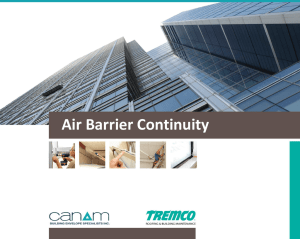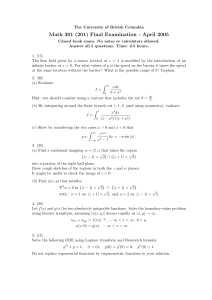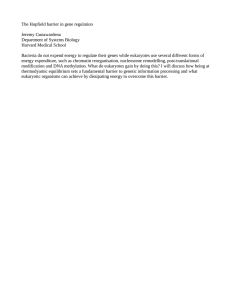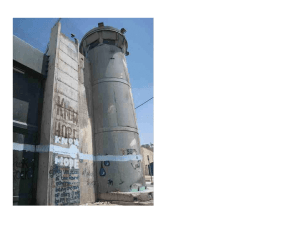ENGINEERING AND C B
advertisement
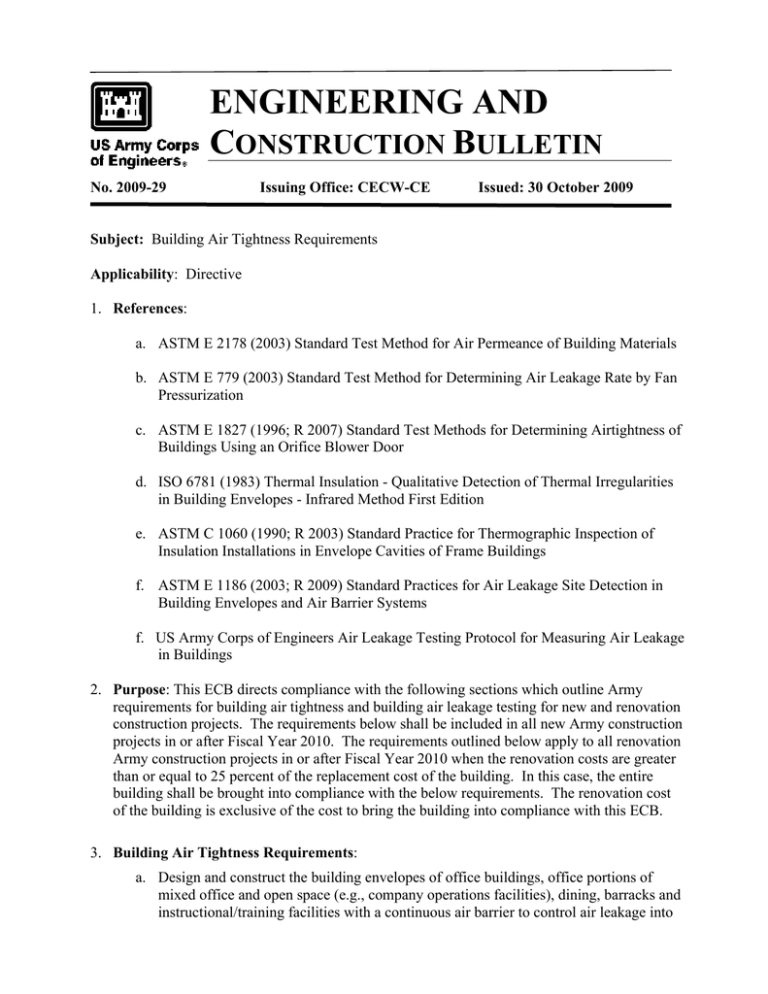
ENGINEERING AND CONSTRUCTION BULLETIN No. 2009-29 Issuing Office: CECW-CE Issued: 30 October 2009 Subject: Building Air Tightness Requirements Applicability: Directive 1. References: a. ASTM E 2178 (2003) Standard Test Method for Air Permeance of Building Materials b. ASTM E 779 (2003) Standard Test Method for Determining Air Leakage Rate by Fan Pressurization c. ASTM E 1827 (1996; R 2007) Standard Test Methods for Determining Airtightness of Buildings Using an Orifice Blower Door d. ISO 6781 (1983) Thermal Insulation - Qualitative Detection of Thermal Irregularities in Building Envelopes - Infrared Method First Edition e. ASTM C 1060 (1990; R 2003) Standard Practice for Thermographic Inspection of Insulation Installations in Envelope Cavities of Frame Buildings f. ASTM E 1186 (2003; R 2009) Standard Practices for Air Leakage Site Detection in Building Envelopes and Air Barrier Systems f. US Army Corps of Engineers Air Leakage Testing Protocol for Measuring Air Leakage in Buildings 2. Purpose: This ECB directs compliance with the following sections which outline Army requirements for building air tightness and building air leakage testing for new and renovation construction projects. The requirements below shall be included in all new Army construction projects in or after Fiscal Year 2010. The requirements outlined below apply to all renovation Army construction projects in or after Fiscal Year 2010 when the renovation costs are greater than or equal to 25 percent of the replacement cost of the building. In this case, the entire building shall be brought into compliance with the below requirements. The renovation cost of the building is exclusive of the cost to bring the building into compliance with this ECB. 3. Building Air Tightness Requirements: a. Design and construct the building envelopes of office buildings, office portions of mixed office and open space (e.g., company operations facilities), dining, barracks and instructional/training facilities with a continuous air barrier to control air leakage into (or out of) the conditioned space. Clearly identify all air barrier components of each envelope assembly on construction documents and detail the joints, interconnections and penetrations of the air barrier components. Clearly identify the boundary limits of the building air barriers, and of the zone or zones to be tested for building air tightness on the drawings. b. Trace a continuous plane of air tightness throughout the building envelope and make flexible and seal all moving joints. The air barrier material(s) must have an air permeance not to exceed 0.004 CFM/sq ft at 0.3 iwg [0.02 L/s.m2 @ 75 Pa] when tested in accordance with American Society for Testing and Materials (ASTM) E 2178. Join and seal the air barrier material of each assembly in a flexible manner to the air barrier material of adjacent assemblies, allowing for the relative movement of these assemblies and components. c. Support the air barrier so as to withstand the maximum positive and negative air pressure to be placed on the building without displacement, or damage, and transfer the load to the structure. Seal all penetrations of the air barrier. If any unavoidable penetrations of the air barrier by electrical boxes or conduit, plumbing, and other assemblies are not air tight, make them air tight by sealing the assembly and the interface between the assembly and the air barrier or by extending the air barrier over the assembly. The air barrier must be durable to last the anticipated service life of the assembly. Do not install lighting fixtures with ventilation holes through the air barrier. d. Provide a motorized damper in the closed position and connected to the fire alarm system to open on call and fail in the open position for any fixed open louvers such as at elevator shafts. Damper and control to close all ventilation or make-up air intakes and exhausts, atrium smoke exhausts and intakes, etc when leakage can occur during inactive periods. Compartmentalize garages under buildings by providing air-tight vestibules at building access points. Provide air-tight vestibules at building entrances with high traffic. e. Compartmentalize spaces under negative pressure such as boiler rooms and provide make-up air for combustion. 4. Building Air Leakage Testing The construction contractor’s testing agency shall demonstrate performance of the continuous air barrier for the building envelope by the following tests: a. Test the completed building and demonstrate that the air leakage rate of the building envelope does not exceed 0.25CFM/sq ft at a pressure differential of 0.3 iwg (75 Pa) in accordance with ASTM E 779 or ASTM E 1827. Accomplish tests using BOTH pressurization and depressurization. The preferred test method is to divide the average measured air leakage flow rate in both directions in CFM @ 0.3 iwg (L/s @ 75 Pa) by the surface area of the envelope enclosed by the continuous air barrier of the building, including roof or ceiling, walls and floor to produce the air leakage rate in CFM/sq ft @ 0.3 iwg (L/s.m2 @ 75 Pa). If the 75 Pa pressure differential cannot be achieved then perform a multi-point test in both directions from at least + 25 to + 50 Pa, then - 25 to 50 Pa and calculate the leakage in CFM @ 0.3 iwg (L/s @ 75 Pa). The testing agency must achieve at least 50 Pa, but there is no requirement that a maximum pressure of 75 Pa be achieved. The maximum testing differential pressure should not exceed 75 Pa. 2 b. In addition to reporting the normalized air leakage, the testing agency is also required to report the correlation coefficient (r2) and 95 percent Confidence Intervals (95%CI) to determine the accuracy of the data collected and the quality of the relationship between flow and pressure that was established during the test. The 95%CI should be calculated in strict accordance with the methodology contained in ASTM E 779 and the r2 value can be obtained by data analysis of the plotted data. For the collected data to be statistically significant, the 95%CI must not exceed 0.02 for mean values of 0.25 or less, which equates to approximately 8 percent. The r2 value must be above 0.98 for the data to be statistically significant c. Do not perform the pressure test for the building until verifying that the continuous air barrier is in place and installed without failures in accordance with installation instructions so that repairs to the continuous air barrier, if needed to comply with the required air leakage rate, can be done in a timely manner. d. Test the completed building using Infrared Thermography testing. Use infrared cameras with a resolution of 0.1 °C or better. Perform testing on the building envelope in accordance with International Organization for Standardization (ISO) 6781 and ASTM C 1060. Determine air leakage pathways using ASTM E 1186, and perform corrective work as necessary to achieve the whole building air leakage rate specified in (a.) above. e. Submit the qualifications and experience of the testing agency for approval prior to testing. f. Notify the Government at least 3 working days before the tests to provide the Government the opportunity to witness the tests. Provide the Government written test results confirming the results of all tests. Additional information about the Army’s Building Air Tightness and Building Air Leakage Testing Requirement may be found in “US Army Corps of Engineers, Air Leakage Testing Protocol for Measuring Air Leakage in Buildings.” This protocol is available on the Whole Building Design Guide website- http://www.wbdg.org/references/pa_dod_energy.php. 5. HQUSACE POC for this action is Mr. Robert Billmyre, CECW-CE, 202-761-4228, Robert.B.Billmyre@usace.army.mil. //S// JAMES C. DALTON, P.E. Chief, Engineering and Construction Directorate of Civil Works 3

